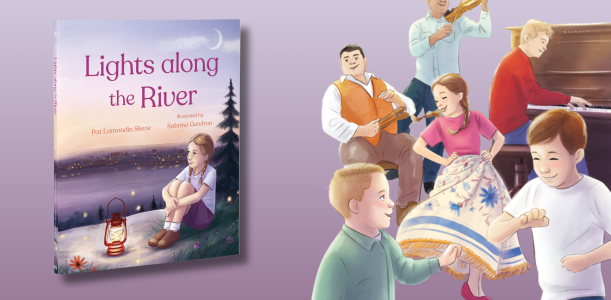
Inspired by the true story of electricity coming to Britt, Ontario, in January 1952, years after much of North America had already been connected to the grid, Lights along the River paints a picture of what small-town life was like for children seventy years ago when there were no electronic devices for entertainment.
Hear from author Pat Lamondin Skene on what it was like to write about her childhood memories and what she hopes readers will take away from her new picture book.
What inspired you to write Lights along the River?
That winter day in 1952 when electricity came to my town has always remained vivid in my memory. I see those days as “before and after” pictures of my life. Electricity didn’t make things better or worse for me as a child, just different. It brought a lot of change into how we lived. I thought about children today and all the electronics they enjoy in their lives. I wanted to bring readers a real story that would help them to see the world in a different way. Perhaps they might think about what it would be like to live without electricity. Or imagine what changes they might see over the course of their own lives.
What was it like for you to put a childhood memory into a picture book?
It was an emotional experience for me. Remembering all the details of those days brought back thoughts of my mom, dad and siblings. The very talented illustrator, Sabrina Gendron, wanted every detail to be as authentic as possible. She asked to see old pictures and had me sketch out the interior layout of my house. She wanted to know what clothes we wore back then and what we ate. Sabrina even included the same wallpaper we had in our living room. It’s amazing to be able to share the life we had seventy years ago, and see my family come alive within the pages of this book.
What strategies did you use to remember the details of that day?
I still go back to my hometown of Britt every summer for a visit. So, the details of every place mentioned in the book, like the Big Rock, the Magnetawan River and the Gereaux Island Lighthouse, are always with me. Even my family’s house, which is illustrated in this book, is still there, owned by someone else now. I also looked at lots of old pictures and talked to various family members to confirm certain facts. I ate a lot of my favorite childhood breakfast of fried apples with cinnamon while writing this story.
What did your process for writing the book look like?
I surrounded myself with pictures of my family and ancestors. I closed my eyes and visualized my life back then, engaging my sense of taste, smell, hearing, vision and touch. I would immerse myself into the scene I was writing, and it would take shape like a storyboard in my mind. Then I wrote what I saw happening, as the story moved along in my imagination. Often, I would get so involved in the scene I was writing that I’d forget to eat!
You note in the story that “Dad’s family is Métis. But we don’t use that word…People are not always kind when they know you are Indigenous.” Has your relationship with your Indigenous ancestry changed, compared to when you were a child?
It was always confusing to me as a child, why we couldn’t discuss who we were. But today is different, and people are interested in learning more about what it’s like to be Métis. Without fully knowing why, I have always had an Indigenous way of being. For decades, I’ve collected Ojibwe-crafted boxes, made from porcupine quills, birch bark and sweetgrass. I was instinctively drawn to these beautiful creations. About ten years ago, my family began working on our genealogy and family tree, going back hundreds of years. It was amazing to find that some of my ancestors were Ojibwe. Becoming an official Métis citizen in 2021 brought everything full circle. I am very proud to self-identify as Métis.
What main takeaways do you hope for readers after they finish your book?
I hope my story, along with Sabrina’s wonderful illustrations, will allow children to immerse themselves into a different time and place. Today’s readers will go through many changes in their own lives, and change isn’t aways easy to accept. But embracing change is part of life. Lights along the River was a moment in time when my world shifted into a different way of living. Today, I’m a grandmother who enjoys all the electronic devices you can imagine. Even my vacuum cleaner is a robot! I wonder what my mother would think of that.
Is the character Mrs. Gendron named after the illustrator of Lights along the River, Sabrina Gendron?
I wondered the same thing and asked Sabrina, but it seems the two are not related. It was just a funny coincidence.
Is there anything else you’d like to add?
I’d like to tell you about these details, originally included in the story.
My first school bus in 1950 was a big wooden boxy wagon, pulled by a team of horses. It was painted red and white, and dark inside. It had two long benches for the students to sit on. During the winter, the wheels were replaced with sleigh runners to glide across the snow. Not long after we had electricity, we got a regular motorized school bus. The old bus was moved into a local man’s backyard and used as a chicken coop for another twenty years.
Before we had electricity, we had to keep food cold without a refrigerator. We had an icebox on the porch to keep our food cold. Every winter, a team of horses pulling a large sleigh would deliver a big load of ice blocks to our icehouse in the backyard. The men would pile the ice blocks up high and cover it with layers of sawdust to keep it from melting in the warmer weather. We had to put a block of ice in our icebox every day. The icehouse was a great place to play on a hot summer day.
What’s next for you? Do you have any other books in the works?
Yes, I’m very excited about a new chapter book I’m working on with Orca Book Publishers. It’s a story about a Métis girl who gets herself into quite a pickle! I’m having so much fun writing this one. I even get to include my Ojibwe quill boxes in the story. It will be out in 2025.

Pat Lamondin Skene retired from the world of banking to find her voice. She is a Métis author of seven books for children, including What a Hippopota-Mess!, Rhyme Stones and Monster Lunch. Her forthcoming memoir, Swiftly Flowing Waters, shares more stories of her childhood growing up on the Magnetawan River. Pat keeps her imagination fed and watered in Oakville, Ontario.



